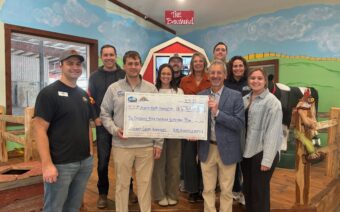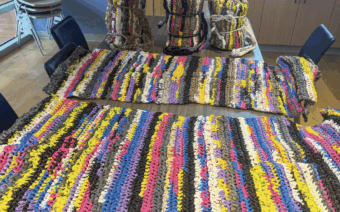
March 3, 2025
MARSHFIELD – When the United States experienced what the Centers for Disease Control and Prevention (CDC) said is the largest documented outbreak of the fungal infection blastomycosis ever, the Marshfield Clinic Research Institute (MCRI) was called upon to lead the investigation.
Per the CDC, between Nov. 1, 2022 and May 15, 2023, 162 cases were identified, resulting in one fatality.
In addition to the number of people infected, the CDC has also noted the significance of the outbreak’s setting, having occurred among workers at a paper mill in Escanaba, Michigan – the first recognized blastomycosis outbreak in an industrial, largely indoor setting.
Jennifer Meece is the executive director of the Integrated Research and Development Laboratory at MCRI, which has researched blastomycosis for more than 20 years.
Meece said the mill took action as soon as a pattern of unusual illness was detected, immediately initiating an investigation of local, state and federal public health authorities.
Per CDC’s report:
- In early March 2023, Public Health Delta and Menominee Counties (Michigan) reported a cluster of blastomycosis cases among paper mill workers to the Michigan Department of Health and Human Services (MDHHS)
- MDHHS subsequently notified CDC
- On March 17, 2023, paper mill management requested a health hazard evaluation (HHE) from the CDC’s National Institute for Occupational Safety and Health (NIOSH) to investigate potential workplace exposure and recommend prevention and control measures at the mill
“The paper mill did exactly all of the right things,” Meece said. “Once they recognized something was going on, they did everything: public health contacts, got in touch with NIOSH – that was all activated. Of course, they obviously care about their employees, so they wanted to see whether or not there was anything that they could do to mitigate (the outbreak).”
Meece and her team at MCRI were soon contacted to lead the investigation of testing environmental samples to identify the source of the blastomycosis, “a tricky bug” of an infection she said she’s researched throughout the Midwest for more than 20 years.
“When (a blastomycosis outbreak) like this happens, we’re often the people with some of the most experience in doing this, so we get a call,” she said of her team.
Meece said it was an honor to be entrusted as part of such an important and high-profile investigation.
“Our role as researchers is to help with discovery and help with prevention and education,” she said. “It’s a privilege to work with such great colleagues and smart, smart people.”
What is blastomycosis?
The CDC describes blastomycosis as “a rare fungal disease often initially misdiagnosed, which can contribute to severe pulmonary illness.”
“Blastomycosis is difficult to diagnose because its symptoms often mimic other respiratory illnesses, like pneumonia, making it hard to distinguish clinically,” Meece said. “Diagnosis requires seeing the fungus in tissue samples through a culture or microscope.”
She said most doctors invariably invoke the principle of Occam’s razor – “the simplest explanation is usually the correct one” – and when an X-ray of blastomycosis-infected lungs appears indistinguishable from that of a far more common bacterial pneumonia infection, antibiotics are often prescribed.
Meece said it’s typically only when the antibiotics fail to treat the illness that blastomycosis is considered and tested, and a more suitable antifungal medication is prescribed.
Per MCRI, between blastomycosis’ two-week to three-month incubation period and its subsequent, common misdiagnosis, results of the infection range from mild, respiratory symptoms to severe, potentially fatal pneumonia.
Meece said the infection does not spread from person to person, rather it’s caused by inhalation of Blastomyces fungal spores from the environment, found in moist soil or decaying wood and leaves, often near rivers and lakes.
“We don’t have a great understanding of what triggers it to go into outbreak mode,” she said. “Obviously, anything soil-borne is tied to the environment, temperature, soil type, acidity, pH – all those sorts of things.”
Though it’s fortunate blastomycosis cases are relatively rare, Meece said the infrequency makes it more difficult to study.
“Because it happens so sporadically, after all these years, we (researchers) don’t have a great handle on it,” she said.
What is known, though, is the Upper Midwest provides suitable conditions for the spores, and Meece said a baseline of a small number of cases can be expected in the region.
Major outbreaks are much rarer, she said, as the Escanaba mill incident was just the fourth such that MCRI has investigated and studied.
“There was one in Merrill a number of years ago that was associated with a landfill and movement of landfill materials,” Meece said. “There was one that we investigated on the Wolf River among recreational tubers. Another one that we investigated was never identified to a point source, but it was in Marathon County, and there was a high incidence of Hmong population that was affected. So, they’re all a little bit different.”
What was most exceptional about the outbreak in Escanaba, Meece said, wasn’t only its magnitude, but the fact it was the first major incident to occur indoors.
“The mill’s location along a riverway in a wooded environment is consistent with Blastomyces’ habitat,” MCRI reported. “Blastomyces typically does not propagate indoors; the spores potentially entered the building through unfiltered ventilation systems, open doors and caused the exposure over several months.”
Meece said after the mill completed “a complete decontamination, inside and out,” no cases of blastomycosis have since been identified.
The investigation
The CDC, based on a survey the agency conducted in collaboration with NIOSH, concluded more than a quarter of the mill’s 645 workers had been infected with blastomycosis.
Meanwhile, Meece said she and her team of six or so people worked on the project from start to finish.
She said MCRI researches all manner of infectious diseases – respiratory, viral and bacterial pathogens, as well as tick-borne diseases and blastomycosis.
“We’re not sitting around waiting for (outbreaks like) this to happen,” she said. “We have our everyday work. We’re always trying to balance priorities, but this one rose to the top pretty fast, because you need to react to it in a timely manner.”
Meece said Blastomyces are divided into two species: B. dermatitidis and B. gilchristii.
“The funny thing about those two bugs is that despite our attempts to identify it in the environment, it is incredibly elusive, so you can’t really sit around and wait,” she said.
For example, when one of her colleagues successfully identified Blastomyces in the environment, Meece said a mere two weeks later, the spores couldn’t be found again.
For MCRI’s testing, Meece said NIOSH collected more than 500 samples from the mill, including soil, wood chips and indoor surface dust, as well as water, dust, duct lining and filters from HVAC systems.
“We had big, industrial air filters sent to us,” she said. “(NIOSH) took nearly every kind of sample you might envision taking in a big facility like that, all based in logic.”
Meece said her team proceeded to test for weeks on end, yet aware “it is rare, if not unheard of, that the exact source of a blastomycosis outbreak has ever been detected in the environment.”
She said though MCRI conducted molecular work on the samples, she would also send a portion to Associate Director Alana Sterkel at the Wisconsin State Laboratory of Hygiene to conduct culture-based work.
“(Sterkel and I) were working in tandem week after week, shooting samples back and forth,” Meece said.
The investigation featured a high level of collaboration throughout, she said, with “lots of communication, calls, progress reporting, emails and team meetings” across organizations and agencies.
Still, even with the massive cooperation and sample collection, Meece said finding “the elusive bug” at the 2,000-acre mill site was akin to finding “a needle in a haystack – in a field of haystacks.”
Unfortunately, she said, though not unexpectedly, the team was not able to identify the source of the outbreak.
“We go into (investigations) with the best intent to try and help understand (how it happened),” she said. “We worked hard to do that, and of course, it would be nice to have the ‘smoking gun,’ but we didn’t.”
Nonetheless, Meece said she and her team were not discouraged.
She said she views the outbreak as an opportunity to educate the public – “for people to remember that (blastomycosis) is actually a thing that we Wisconsinites may deal with, and may see in a clinic or our own lives.”
“I always say this about most anything I do in the world of infectious diseases: every single person needs to be keenly aware of their own well-being and their health,” she said. “Blasto(mycosis) isn’t something (where) you shouldn’t go outdoors, because you might get it. But be mindful of your well-being… If you’re not getting better, or not feeling better after seeing a physician for treatment, you’re your own best advocate for your well-being.”
Prevention of future cases is the collective goal of such an investigation, and Meece said she’s grateful for the Marshfield Clinic’s philanthropic support of the work, as well as the “multi-state, multi-agency, private-public partnership” undertaken.
“When you can get people across various agencies and states communicating, talking to each other for the betterment of public health, that’s pretty cool,” she said. “Though we didn’t identify the source, (the organizations) clearly, through their actions, stopped any additional cases from occurring.”
Cases like these only strengthen the resolve of teams like hers, Meece said.
“The thing about blastomycosis researchers – we’re not going to give up,” she said. “Every time, you wish you could do more, but we just keep trying. Every time we get called upon, we will answer the call.”
 GB Blizzard to take on UWGB ‘alter ego’ – the Frozen Phoenix
GB Blizzard to take on UWGB ‘alter ego’ – the Frozen Phoenix Making a Difference: Keeping a father’s legacy alive
Making a Difference: Keeping a father’s legacy alive








